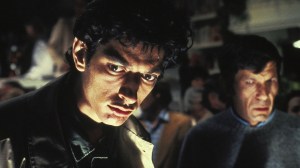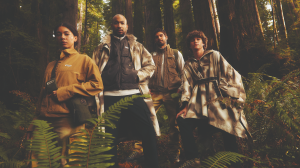
The Death-Defying Doctor Mirage proved to be another fantastic new launch in a seemingly perpetual winning streak for Valiant Entertainment last year. It was dark, dramatic, and surprisingly droll. Now the same creative team is returning to detail what happens after Shan is re-teamed with her ghostly husband Hwen. We had an opportunity to speak with writer Jen Van Meter and e-mail artist Roberto de la Torre in Spain about their return to the Valiant universe and what has them excited about round two.
Videos by ComicBook.com
This is your second time telling a Doctor Mirage story. What made you want to come back after the first series?
Jen Van Meter: When we figured out what the first story was going to be and the trajectory was going to be Shan finding Hwen, the moment we had that nailed down I knew I wanted to do the next story because it was all aimed toward there being more with them together. I knew I wanted to come back before I finished issue one. I fell in love with her writing that first series, and with them, but I had so little time writing them together that in between I was really looking forward to writing them together. It has been really fun.
Roberto de la Torres: I love that the characters are not stereotypes.
That’s one thing that’s instantly noticeable in the first issue. Shan still reads like Shan, but now they are reunited and acclimated to one another again, the dynamics and her personality are noticeably changed. What attracts you most to this new dynamic?
Van Meter: I like writing couples; I like writing family relationships; I like writing intensely personal relationships. In their case in particular, I have found that as a pair of people who are very much in love with another, and also have a unified passion for very specific goals, I really love that about them. The focus is really on how much better they are together: emotionally, psychologically, and at their jobs.
One of the things I have been playing with, and it’s touched on in the first series, is that as a team they had built a career path for themselves where Shan was brittle with living people, but very compassionate and empathetic with the dead, whereas Hwen was the person who could shake hands, be friendly, and engage living people. So as a team they worked very well together. They had ways of engaging both sides of their world and without him she was really isolated.
That first arc was about her having to find the strengths she didn’t know she had or had been doing without. Not knowing she would get him back, she had to do it on her own. When she gets him back, she doesn’t need that other skillset in the same way.
Those strengths haven’t faded entirely either. In The Death-Defying Doctor Mirage: Second Lives #1, she’s noticeably more affable and treats Leo with a good sense of humor.
Van Meter: She’s not grieving anymore or down in that hole of her own sorrow. She also discovered some things about herself that helps her find a sense of humor and find herself again. At the same time they now have slightly different roles because she’s not the only one who can talk with ghosts, but she is the only one who can interact with the living world. It has sort of switched their jobs and the partnership.
One of the things I’ve been playing with is that they thought, “This is awesome! We’re getting our old relationship back!”, but what they’re actually doing is building a brand new one. They’re still in love, but they have to figure out how to do this version of their relationship.
One other thing the first issue reminded me of is Sternberg’s Theory of Love, where there are three major components of love: intimacy, passion, and commitment. Even though they’re reunited, one of those components is now missing as they cannot physically interact. It’s a subtle point of tension here as they try to get back to what they understood as normal.
Van Meter: I think this is something that we do, where you say you want to get back to normal and part of that is finding out what the new normal is, especially when something has been lost or changed. You sometimes spend too much time looking backward until you can figure out how to look forward. That’s a lot of what this arc is about. This is completely new territory for them, so they have to figure out what works.
Of course there are going to be plenty of distractions and derailments as well. The rest of the world demands their attention. That’s what makes it a superhero story. You have your own stuff going on and, suddenly, there’s a cat in a tree. They’re going to have to go deal with this other stuff. That’s pretty relatable too. We have so much to deal with in our own relationships, but you still have to do the laundry and go to your job. That tension is a really normal tension of them figuring out how to manage the different components of their life. They just have this extra component, which is the entire population of ghosts they deal with.
That’s one thing I like about the first series and the start of this new one, that there is this very emotional, human core of handling life beyond all of the world-threatening threats. I think the connecting thread between the two series is the act of grieving. In the first series it was grieving for someone who was lost from your life. Now it’s grieving for a relationship and a way of life that you can’t get back.
Van Meter: That’s right and I suppose it makes me sound morbid. Give Jen Van Meter a comic book to write and she’ll give you this treatise on grieving. But the minute you look at what’s at the center of these stories, this woman who can talk to ghosts, you don’t get ghosts without death and loss. It’s going to be thematically present all of the time.
One of the joys about this second series is that it’s not just about death and loss. It’s also about opening a door so we can see this world as Shan and Hwen see it with this enormous population of ghosts. There’s a bit in issue two that I really like about how it’s not the haunted houses that are scary, but the ones that have been abandoned. If the ghosts aren’t there, that’s when the bad stuff can get in. I like building this idea of an unseen population who are looking out for us and keeping things healthy, and Shan and Hwen as advocates for them.
It has been giving me a great deal of satisfaction to explore because I don’t want it to just be about what they don’t have. I also want it to be about what they do have.
That’s certainly present throughout the first issue. While there are themes of mourning and grief, there’s also a great sense of humor and quite a bit of fun. I think anyone reading this comic will have dealt with mourning in some form, and will recognize that when you lose something it’s not a constant state of sorrow. There is laughter and a wide range of other emotions as you learn to let go.
Van Meter: It’s certainly something I’ve tried to be as honest as I can be about it. Grief is one of those strange things where it’s completely universal, but also, much like puberty, the nature of it is to make you feel isolated like no one has ever felt like this before. The universality of it is to feel very isolated by it. It’s such a complicated thing, loss and mourning. Those things don’t come at you as a solid mass. They come at you with other things mixed in, like that odd moment of laughter, followed by the guilt about the laughter, and it all swirls.
Trying to be honest about that for Shan and Hwen and for the incidental characters they encounter has probably been the hardest part of the book because you want to keep things moving and keep the pace of the story exciting and engaging, but you also want to take some time over those things.
That thematic core is definitely difficult stuff to tackle, but Doctor Mirage is also a very fun book and lends itself well to interesting, visual storytelling. That’s something I think Roberto [de la Torre] has done a very good job with. His work, along with the coloring and lettering, does a really good job of cueing readers into who can perceive what and what properties different characters possess in each panel. What appeals to you most about telling Doctor Mirage in a visual medium?
Van Meter: The last time I wrote prose fiction, not for a comic, was probably five years ago. At this point I tend to think of how it’s going to look because I think of it as a comic right away. I’ve just conditioned myself so that’s how I think about storytelling, which is a little bit unfortunate because I have some notes for things I would like to do in prose. But I haven’t used those muscles in a long time.
I can’t imagine trying to tell a story about Shan and Hwen in any other medium. They were born in comics and it would be up to somebody else to imagine it for another medium. I do love both the puzzle element and the very exciting collaboration that comes with working with Roberto and David [Baron] and Dave [Lanphear]. Throughout the first series and now the second, I sit down to write a script and I have an idea of what Roberto is going to do.
There’s going to be this real world with people and ghosts in it, and while his line is going to change a little bit they’re going to be there just like people. Then David Baron will color it to bring the lightness and that washed out quality to the ghosts. They’ll be in communication about that stuff. But I know when I’m scripting it’s not a hassle to tell Roberto there’s going to be all of these people sitting around a table talking and the ghosts are going to be right in there with them, but the people don’t know to make room for the ghosts, so they’re overlapping. He’ll just know what to do. I’ll just tell him it’s like a family sitting down to dinner, but one half doesn’t know the other half is there, and he’ll just run with it.
He has such an exquisite gift for the feel of a scene that if I say the big deal here is everybody is really cozy or really tense, he’ll bring that to every line and every detail. I think he is very at ease with the idea of who can see what. It is my responsibility to make sure I’m clear and it can get tricky sometimes making sure we’ve got it right, but it’s a fun puzzle making sure we’ve got it right. There’s a lot of communication about how the visuals are going to convey who is seeing and hearing what.
I love that this project really forces us to communicate through every stage of art all the way down to lettering. I’ve worked on a lot of things where it’s just a script and I haven’t even been told who the artist is going to be. The artist hands it in, then the colorist hands it in, and you don’t see it until the letterer is done. When that’s done you can still get a great comic, but the sense of collaboration with everyone pointing towards the same goal gets diluted. With this one we can’t afford to let that sense of communication drop because there are so many tricky details.
There are definitely a lot of large publishers where an editor will do the majority of communication between different aspects of a team. Has this level of collaboration and coordination been unique to your experience at Valiant?
Van Meter: Everything about this project is pretty unique for me in that sense. I worked on Black Lightning: Year One with Cully Hamner and Rachel Gluckstern at DC Comics, there was a great deal of communication. When I worked on the Black Cat mini-series at Marvel with Steve Wacker and Javier Pulido, there was no shortage of communication. Sometimes it’s there because the relationships are already there. Sometimes it’s there because it’s absolutely crucial. Sometimes it just works out beautifully.
In other cases I’ve done jobs where I’m being asked to do a fill-in issue on something and the schedule is just moving too fast for a lot of that communication to happen. I’m happy to do it; I don’t mind jobs like that. I enjoy, to a certain extent, the puzzle solving that comes in a job where it has to be done quick and here’s what’s got to happen. There are certain demands of craft that come with a job like that, that are pleasurable for me.
But being able to be on the same page from the start with this team and this character, both for the first series and now this, in a house where there’s so much continuity but everyone is in really close communication throughout the publishing line, that’s a novel experience for me. It’s different from creator-owned work, but the Valiant work has been just a delight.
There is something about this series that feels very comfortable or settled in its own way. At no point is there a panel where it reads like the creative team is second guessing the work or its execution. Having already worked with this entire creative team once before on the same characters, do you script with those people in mind?
Van Meter: Absolutely. Over the years I have adopted a style where my panel descriptions have less about what we see and more about how it feels. While that was all super useful to Roberto, he wanted to know up front, “What is it you’re seeing?” I was not thinking as clearly as I might have been for him, so I have gotten the scripts now to a place where the combination of what we see and how it feels is more harmonious for him. Now that we’ve worked together several times, it’s no longer a question for me.
I’ll spend hours staring at a page asking what people should say and how things should go, but the part where I’m conveying that for Robert, Dave, and David has gotten a ton easier. I’m pretty sure what they need to know from me. The hardest part now is just figuring out what’s the coolest thing or what’s the neatest thing that can happen next and how I do that. They are all glorious artists and super attentive to the characters.
We are all very protective of Shan and Hwen at this point in a way that makes me happy because we’re all aiming for the same place. We all want them to look great, do great things, and just be awesome.
What has you most excited about the second series then?
Van Meter: It changes every day. Right now I’m really excited about the stuff in the first issue set in Barcelona because I think it came out so beautifully, and I’m excited for people to see it. There’s a lot of Shan and Hwen being great together that’s coming. There’s some bad magic coming that I think is going to be really fun to see on the page.
I’m intrigued by trying to tell a lighter story in a setting that we have let get dark and intense. That has been a really fun, tricky challenge, making sure things stay light amidst dark, tricky stuff in a way that’s pleasing to me without turning callous. They don’t ignore the problems of others; that’s not who they are.

Of course! I’ve interacting more with Jen for this series, trading ideas. This has helped us craft a very personal story. Working with our editor Alejandro is always a pleasure. He collaborates with Jen and with I, and we all discuss how best to figure out each page. He even helps me out with Spanish translations if I’m ever puzzled by any part of the script. Then there’s David Baron’s coloring; he collaborates very closely with us, and together we all create a singular atmosphere for the comic. And Dave Lanphear… he’s a phenomenon!
One of the biggest challenges in the series is differentiating between ghosts and people, and who can see what. How do you vary your technique and tools when drawing these two sets of characters? Torres:The single biggest challenge is drawing all of the characters’ feelings. Sometimes it would be easier to draw the Hulk smashing a city than to draw one of Shan’s emotional reactions. As for the ghosts, it depends on the scene. Sometimes they need more shadows and contrast, while other times they’re more transparent and ethereal. And some times they’re barely visible at all. I base myself more on their emotional state and the importance of their role in the scene. They’re ghosts, so I don’t think they need to respond to light sources the way a solid body does.
The series also focuses on a lot of small human moments of humor and romance. What do you most enjoy about drawing Shan and Hwen interacting? Torres:I love their humor together. The Death-Defying Doctor Mirage: Second Lives #1 is scheduled to release on December 23, 2015.








